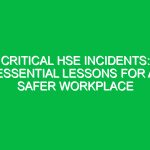Introduction
Good morning, team! Today, we are holding a toolbox talk focused on an often-overlooked yet crucial aspect of our work Environment: housekeeping. Maintaining a clean and organized workplace is not just about aesthetics; it plays a vital role in our health, safety, and environmental (HSE) practices. By the end of this session, you will understand how effective housekeeping can prevent accidents and create a safer working environment for all of us.
The Importance of Housekeeping in HSE
First, let’s discuss why housekeeping is critical in the HSE context. Good housekeeping practices help to:
- Minimize the risk of accidents and injuries.
- Enhance productivity and efficiency.
- Improve morale and promote a sense of pride in the workplace.
- Comply with legal and regulatory Standards.
When we keep our work environment tidy, we reduce Hazards such as slips, trips, and falls, which are among the leading causes of workplace injuries. A clutter-free space allows us to work more efficiently, as we spend less time searching for tools or materials.
Key Aspects of Effective Housekeeping
Effective housekeeping can be broken down into several key aspects:
1. Organization
Every tool, material, and piece of equipment should have a designated place. This not only makes it easier to find what you need but also prevents clutter. For example, imagine trying to find a wrench in a messy toolbox. It’s frustrating and time-consuming. Instead, we should organize tools in a systematic way, perhaps using labels or color coding.
2. Cleanliness
Regular cleaning schedules are essential. This includes sweeping, dusting, and removing waste. A clean work area reduces the risk of contamination and promotes a healthier environment. For instance, not cleaning up spills promptly can lead to slips and falls, which can be easily avoided with a simple cleaning routine.
3. Waste Management
Proper disposal of waste is another critical element of housekeeping. Ensure that trash bins are readily available, and encourage everyone to dispose of waste appropriately. Hazardous materials should be handled and disposed of according to Regulations to prevent environmental contamination and health risks.
4. Maintenance
Regular Maintenance of equipment and facilities is vital. This includes checking for wear and tear or any potential Hazards. For example, if you notice that a step ladder is damaged, report it immediately. Do not attempt to use it, as this could lead to serious injuries.
Potential Hazards Linked to Poor Housekeeping
Failing to maintain good housekeeping can lead to various hazards:
- Slips, trips, and falls: Cluttered walkways or spills on the floor can create dangerous conditions.
- Fire hazards: Accumulated waste or improperly stored materials can increase the risk of fire.
- Equipment damage: Poorly stored tools can lead to damage and increased maintenance costs.
- Health risks: Dust and debris can accumulate, leading to respiratory issues or other health problems.
Best Practices for Housekeeping
Now that we understand the importance of housekeeping and the risks involved, let’s discuss some Best Practices to implement in our daily routines:
1. Create a Housekeeping Schedule
Establish a regular cleaning and maintenance schedule. Assign specific tasks to team members to ensure accountability. For example, you might have a weekly clean-up day where everyone pitches in to tidy up the workspace.
2. Conduct Regular Inspections
Regularly inspect the workplace for potential hazards. This can be done during routine Safety audits. Encourage employees to report any concerns they may have regarding housekeeping practices.
3. Provide Training
Training is essential. Make sure everyone knows how to maintain housekeeping standards, handle waste, and identify hazards. Training sessions should include practical demonstrations to ensure understanding.
4. Lead by Example
As team members, we should model good housekeeping practices. When employees see management and their peers adhering to high standards of cleanliness and organization, they are more likely to follow suit.
Real-Life Examples and Scenarios
To illustrate the importance of housekeeping, let’s consider a couple of scenarios:
Scenario 1: The Slip Hazard
Imagine a scenario where a worker spills a small amount of oil on the floor but decides to clean it up later. A few hours later, another employee slips on the spill and injures themselves. This situation could have been easily avoided by cleaning the spill immediately. This emphasizes the need for vigilance in maintaining a clean workspace.
Scenario 2: The Cluttered Workspace
In another example, consider a team member who is searching for a tool in a cluttered area. While looking for the tool, they trip over a pile of materials and fall, resulting in an injury. If the area had been organized and free of obstacles, this accident could have been prevented.
Open Discussion
Let’s take a moment to discuss. What are some challenges you face regarding housekeeping in your daily tasks? Are there specific areas where you think we can improve? Your feedback is crucial in creating a safer and more efficient work environment.
Regulations and Standards
Compliance with housekeeping standards is not just a best practice; it is often mandated by regulations. Depending on our industry, there may be specific guidelines set forth by organizations such as the Occupational Safety and Health Administration (OSHA) or local health and Safety authorities. Understanding these regulations helps ensure that we not only protect ourselves but also fulfill our legal obligations.
Conclusion
In closing, effective housekeeping is a fundamental aspect of our HSE practices. By staying organized, maintaining cleanliness, managing waste properly, and performing regular maintenance, we can significantly reduce the risk of accidents and create a safe working environment. Remember, it is everyone’s responsibility to uphold these standards. Thank you all for your attention and your commitment to safety. Let’s work together to make our workplace the safest it can be!


